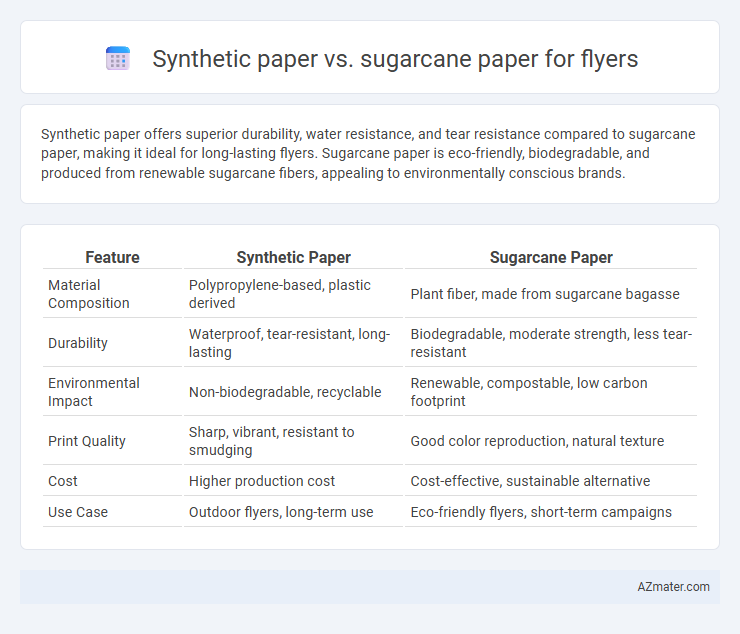Synthetic paper offers superior durability, water resistance, and tear resistance compared to sugarcane paper, making it ideal for long-lasting flyers. Sugarcane paper is eco-friendly, biodegradable, and produced from renewable sugarcane fibers, appealing to environmentally conscious brands.
Table of Comparison
| Feature | Synthetic Paper | Sugarcane Paper |
|---|---|---|
| Material Composition | Polypropylene-based, plastic derived | Plant fiber, made from sugarcane bagasse |
| Durability | Waterproof, tear-resistant, long-lasting | Biodegradable, moderate strength, less tear-resistant |
| Environmental Impact | Non-biodegradable, recyclable | Renewable, compostable, low carbon footprint |
| Print Quality | Sharp, vibrant, resistant to smudging | Good color reproduction, natural texture |
| Cost | Higher production cost | Cost-effective, sustainable alternative |
| Use Case | Outdoor flyers, long-term use | Eco-friendly flyers, short-term campaigns |
Overview: Synthetic Paper vs. Sugarcane Paper
Synthetic paper offers superior durability, water resistance, and tear-proof qualities, making it ideal for flyers exposed to harsh conditions or frequent handling. Sugarcane paper, an eco-friendly alternative, is biodegradable and made from renewable agricultural waste, appealing to sustainability-focused brands seeking environmentally responsible printing options. Both materials provide high print quality, but the selection depends on the flyer's intended lifespan and environmental impact priorities.
Material Composition and Production Process
Synthetic paper is made from polypropylene or polyethylene, offering waterproof and tear-resistant properties through a plastic-based extrusion and calendaring process. Sugarcane paper is produced from agricultural waste, mainly bagasse fibers, using eco-friendly pulping and recycling techniques that reduce environmental impact. The production of sugarcane paper involves less energy consumption and fewer harmful chemicals compared to the synthetic paper manufacturing process.
Environmental Impact and Sustainability
Sugarcane paper offers a significant environmental advantage over synthetic paper due to its biodegradable nature and utilization of agricultural waste, reducing landfill waste and reliance on fossil fuels. Synthetic paper, often made from petroleum-based plastics, poses sustainability challenges because it is less biodegradable and requires more energy-intensive manufacturing processes. Choosing sugarcane paper for flyers supports a circular economy by minimizing carbon footprint and promoting renewable resource use.
Print Quality and Color Vibrancy
Synthetic paper offers superior print quality and exceptional color vibrancy due to its smooth, non-absorbent surface that enhances ink adherence and sharp image reproduction. Sugarcane paper, while eco-friendly and biodegradable, tends to absorb more ink, leading to slightly muted colors and less crisp detail in flyer prints. Selecting synthetic paper ensures brighter, more durable prints ideal for marketing materials requiring high visual impact.
Durability and Water Resistance
Synthetic paper offers superior durability and water resistance compared to sugarcane paper, making it ideal for flyers intended for outdoor use or exposure to harsh conditions. Its tear-resistant properties and ability to withstand moisture without warping ensure long-lasting print quality. Sugarcane paper, while eco-friendly, is more prone to damage from water and general wear, limiting its use to indoor or short-term applications.
Cost Efficiency and Pricing
Synthetic paper offers higher durability and water resistance but comes at a premium cost, making it less cost-efficient for large-scale flyer printing. Sugarcane paper provides a sustainable and eco-friendly alternative with lower material and production expenses, optimizing budget without compromising print quality. Businesses seeking affordable, environmentally responsible flyers often find sugarcane paper the more cost-effective choice compared to synthetic options.
Customization and Finishing Options
Synthetic paper offers extensive customization and finishing options, including matte, glossy, and textured surfaces, making it ideal for vibrant flyer designs with enhanced durability. Sugarcane paper provides eco-friendly finishing choices like natural textures and biodegradable coatings, appealing to brands focused on sustainability without compromising print quality. Both materials accommodate variable sizes, die-cutting, and specialty inks, but synthetic paper excels in water resistance and tear-proof finishes.
Applications and Best Use Cases
Synthetic paper offers excellent durability, water resistance, and tear-proof qualities, making it ideal for outdoor flyers, event promotions, and long-lasting marketing materials. Sugarcane paper, made from renewable agricultural waste, provides an eco-friendly alternative suitable for short-term flyers, brand awareness campaigns, and businesses emphasizing sustainability. Choosing between synthetic and sugarcane paper depends on the flyer's desired lifespan, environmental impact goals, and specific use case requirements.
Disposal and Recycling Compatibility
Synthetic paper offers superior water resistance and durability but presents challenges in disposal due to its plastic-based composition, often requiring specialized recycling processes that are less widely available. Sugarcane paper, derived from agricultural waste, is biodegradable and compostable, making it more environmentally friendly with straightforward disposal through organic recycling streams. Choosing sugarcane paper enhances eco-friendly marketing efforts by ensuring compatibility with standard paper recycling and reducing landfill impact.
Choosing the Right Paper for Flyers
Synthetic paper offers superior durability, water resistance, and tear strength, making it ideal for flyers exposed to outdoor conditions or frequent handling. Sugarcane paper provides an eco-friendly alternative with a smooth finish and natural texture, appealing to environmentally conscious brands aiming for sustainability without compromising print quality. Selecting between synthetic and sugarcane paper depends on the flyer's usage environment and the brand's commitment to environmental impact and longevity.

Infographic: Synthetic paper vs Sugarcane paper for Flyer
 azmater.com
azmater.com